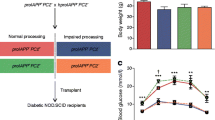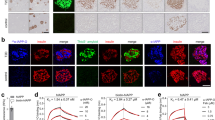Abstract
Aggregation of the â-cell product islet amyloid polypeptide (IAPP) is believed to be an important event in the development of the â-cell lesion in type 2 diabetes. Preamyloidotic oligomeric IAPP assemblies exert toxic effects on â cells that die, leading to reduced â-cell mass. Normal human islets, when isolated and cultured in vitro or transplanted into nude mice, also develop amyloid deposits, which are associated with increased â-cell death and reduced â-cell mass. The possible role of IAPP aggregation and amyloid formation in loss of islet transplant function should be taken into consideration and studied further.
Similar content being viewed by others
References and Recommended Reading
Hull RL, Westermark GT, Westermark P, Kahn SE: Islet amyloid: a critical entity in the pathogenesis of type 2 diabetes. J Clin Endocrinol Metab 2004, 89:3629–3643. State-of-the-art article on the importance of IAPP aggregation for the â-cell failure in type 2 diabetes.
Rochet JC, Lansbury PTJ: Amyloid fibrillogenesis: themes and variations. Curr Opin Struct Biol 2000, 10:60–68.
Kayed R, Head E, Thompson JL, et al.: Common structure of soluble amyloid oligomers implies common mechanism of pathogenesis. Science 2003, 300:486–489. For those who want to get information as to why proteins aggregate into amyloid and how aggregates exert their toxicity.
Kayed R, Sokolov Y, Edmonds B, et al.: Permeabilization of lipid bilayers is a common conformation-dependent activity of soluble amyloid oligomers in protein misfolding diseases. J Biol Chem 2004, 279:46363–46366.
Yuan J, Yankner BA: Apoptosis in the nervous system. Nature 2000, 407:802–809.
Westermark P, Wernstedt C, Wilander E, et al.: A novel peptide in the calcitonin gene related peptide family as an amyloid fibril protein in the endocrine pancreas. Biochem Biophys Res Commun 1986, 140:827–831.
Westermark P, Wernstedt C, Wilander E, et al.: Amyloid fibrils in human insulinoma and islets of Langerhans of the diabetic cat are derived from a neuropeptide-like protein also present in normal islet cells. Proc Natl Acad Sci U S A 1987, 84:3881–3885.
Cooper GJ, Willis AC, Clark A, et al.: Purification and characterization of a peptide from amyloid-rich pancreases of type 2 diabetic patients. Proc Natl Acad Sci U S A 1987, 84:8628–8632.
Wang J, Xu J, Finnerty J, et al.: The prohormone convertase enzyme 2 (PC2) is essential for processing pro-islet amyloid polypeptide at the NH2-terminal cleavage site. Diabetes 2001, 50:534–539.
Smeekens SP, Montag Ag, Thomas G, et al.: Proinsulin processing by the subtilisin-related proprotein convertases furin, PC2, and PC3. Proc Natl Acad Sci U S A 1992, 89:8822–8826.
Ward WK, LaCava EC, Paquette TL, et al.: Disproportionate elevation of immunoreactive proinsulin in type 2 (noninsulin-dependent) diabetes mellitus and in experimental insulin resistance. Diabetologia 1987, 30:698–702.
Westermark P, Li ZC, Westermark GT, et al.: Effects of beta cell granule components on human islet amyloid polypeptide fibril formation. FEBS Lett 1996, 379:203–206.
Janciauskiene S, Eriksson S, Carlemalm E, Ahrén B: B cell granule peptides affect human islet amyloid polypeptide (IAPP) fibril formation in vitro. Biochem Biophys Res Commun 1997, 236:580–585.
Jaikaran ET, Clark A: Islet amyloid and type 2 diabetes: from molecular misfolding to islet pathophysiology. Biochim Biophys Acta 2001, 1537:179–203.
Westermark P: Amyloid and polypeptide hormones: what is their inter-relationship? Amyloid 1994, 1:47–60.
Westermark P, Engström U, Johnson KH, et al.: Islet amyloid polypeptide: pinpointing amino acid residues linked to amyloid fibril formation. Proc Natl Acad Sci U S A 1990, 87:5036–5040.
Westermark P, Johnson KH, O'Brien TD, Betsholtz C: Islet amyloid polypeptide-a novel controversy in diabetes research. Diabetologia 1992, 35:297–303.
Westermark P, Grimelius L: The pancreatic islet cells in insular amyloidosis in human diabetic and non-diabetic adults. Acta Pathol Microbiol Scand [A] 1973, 81:291–300.
Clark A, Wells CA, Buley ID, et al.: Islet amyloid, increased A-cells, reduced B-cells and exocrine fibrosis: quantitative changes in the pancreas in type 2 diabetes. Diabetes Res 1988, 9:151–159.
Butler AE, Janson J, Bonner-Weir S, et al.: Beta-cell deficit and increase beta-cell apoptosis in humans with type 2 diabetes. Diabetes 2003, 52:102–110.
Howard CFJ: Longitudinal studies on the development of diabetes in individual Macaca nigra. Diabetologia 1986, 29:301–306.
Johnson KH, O'Brien TD, Betsholtz C, Westermark P: Islet amyloid, islet-amyloid polypeptide, and diabetes mellitus. N Engl J Med 1989, 321:513–518.
Höppener JWM, Oosterwijk C, Nieuwenhuis MG, et al.: Extensive islet amyloid formation is induced by development of type II diabetes mellitus and contributes to its progression: pathogenesis of diabetes in a mouse model. Diabetologia 1999, 42:427–434.
Verchere CB, D'Alessio DA, Palmiter RD, et al.: Islet amyloid formation associated with hyperglycemia in transgenic mice with pancreatic beta cell expression of human islet amyloid polypeptide. Proc Natl Acad Sci U S A 1996, 93:3492–3496.
Westermark GT, Gebre-Medhin S, Steiner DF, Westermark P: Islet amyloid development in a mouse strain lacking endogenous islet amyloid polypeptide (IAPP) but expressing human IAPP. Mol Med 2000, 6:998–1007.
Butler AE, Janson J, Soeller WC, Butler PC: Increased beta-cell apoptosis prevents adaptive increase in beta-cell mass in mouse model of type 2 diabetes: evidence for role of islet amyloid formation rather than direct action of amyloid. Diabetes 2003, 52:2304–2314.
Butler AE, Jang J, Gurlo T, et al.: Diabetes due to a progressive defect in beta-cell mass in rats transgenic for human islet amyloid polypeptide (HIP Rat): a new model for type 2 diabetes. Diabetes 2004, 53:1509–1516.
Ma Z, Westermark GT, Sakagashira S, et al.: Enhanced in vitro production of amyloid-like fibrils from mutant (S20G) islet amyloid polypeptide. Amyloid 2001, 8:242–249.
Sakagashira S, Sanke T, Hanabusa T, et al.: Missense mutation of amylin gene (S20G) in Japanese NIDDM patients. Diabetes 1996, 45:1279–1281.
O'Brien TD, Butler AE, Roche PC, et al.: Islet amyloid polypeptide in human insulinomas. Evidence for intracellular amyloidogenesis. Diabetes 1994, 43:329–336.
Westermark GT, Steiner DF, Gebre-Medhin S, et al.: Pro islet amyloid polypeptide (proIAPP) immunoreactivity in amyloid formation in the islets of Langerhans. Upsala J Med Sci 2000, 105:97–106.
Westermark P, Eizirik DL, Pipeleers DG, et al.: Rapid deposition of amyloid in human islets transplanted into nude mice. Diabetologia 1995, 38:543–549.
Westermark GT, Westermark P, Eizirik D, et al.: Differences in amyloid deposition in islets of transgenic mice expressing human islet amyloid polypeptide versus human islets implanted into nude mice. Metabolism 1999, 48:448–454.
Shapiro AMJ, Lakey JRT, Ryan EA, et al.: Islet transplantation in seven patients with type 1 diabetes mellitus using a glucocorticoid free immunosuppressive regiment. N Engl J Med 2000, 343:230–238.
Ryan EA, Lakey JRT, Paty BW, et al.: Successful islet transplantation: continued insulin reserve provides long-term glycemic control. Diabetes 2002, 51:2148–2157.
Street CN, Lakey JRT, Shapiro AMJ, et al.: Islet graft assessment in the Edmonton Protocol. Implications for predicting long-term clinical outcome. Diabetes 2004, 53:3107–3114. Summarizes the present knowledge about clinical islet transplantation.
Eizirik DL, Pipeleers DG, Ling Z, et al.: Major species differences between man and rodents in the susceptibility to pancreatic beta-cell injury. Proc Natl Acad Sci U S A 1994, 91:9253–9256.
Westermark GT, Westermark P, Nordin A, et al.: Formation of amyloid in human pancreatic islets transplanted to the liver and spleen of nude mice. Upsala J Med Sci 2003, 108:193–204. One of few articles dealing with the putative role of IAPP aggregation for human islet transplant failure.
Kodama K, Hull RL, Wildbur S, et al.: Amyloid formation following islet transplantation is associated with increased beta-cell apoptosis, decreased beta-cell replication and reduced beta-cell volume [abstract]. Diabetes 2004, 53:A375-A376.
Westermark G, Benig Arora M, Fox N, et al.: Amyloid formation in response to beta cell stress occurs in vitro, but not in vivo, in islets of transgenic mice expressing human islet amyloid polypeptide. Mol Med 1995, 1:542–543.
Author information
Authors and Affiliations
Rights and permissions
About this article
Cite this article
Westermark, P., Andersson, A. & Westermark, G.T. Is aggregated IAPP a cause of beta-cell failure in transplanted human pancreatic islets?. Curr Diab Rep 5, 184–188 (2005). https://doi.org/10.1007/s11892-005-0007-2
Issue Date:
DOI: https://doi.org/10.1007/s11892-005-0007-2




